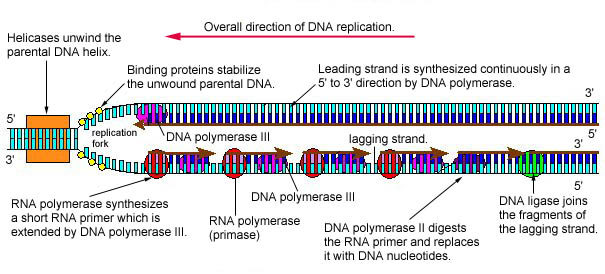Fig. 9: Replication of Leading
and Lagging DNA Strands

The leading strand is made continuously
in a 5' to 3' direction by DNA polymerase III as the DNA helicase unwinds the
parental DNA helix. However, because the parental DNA strands are antiparallel,
the lagging strand must be made in short fragments. RNA polymerase (primase)
synthesizes a short RNA primer which is extended by DNA polymerase III. DNA
polymerase II then digests the RNA primer and replaces it with DNA. Finally,
DNA ligase joins the fragments of the lagging strand together.
Illustration of The Replication of Leading
and Lagging DNA Strands.jpg by Gary E. Kaiser, Ph.D.
Professor of Microbiology,
The Community College of Baltimore County, Catonsville Campus
This work is licensed under a Creative Commons Attribution 4.0 International License.
Based on a work at https://cwoer.ccbcmd.edu/science/microbiology/index_gos.html.

Last updated: Feb., 2021
Please send comments and inquiries to Dr.
Gary Kaiser
